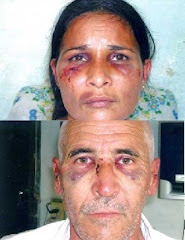The Day Castro and Khrushchev Led the World to the Brink of Nuclear War
/ Ivan Garcia
Posted on October 26, 2015
Ivan Garcia, 25 October 2015 — The eyes of eighty-four-year-old Roman
Galvan come alive as he remembers the dark days of October 1962 when it
seemed that Cuba would be erased from the map following what appeared to
be an impending nuclear conflagration between the United States and the
former Soviet Union.
Fifty-three years later, Galvan lives in a dilapidated state-run nursing
home in La Vibora, a neighborhood half-an-hour's drive from downtown Havana.
"In 1962 I was a militiaman. In October I was called to serve in a
military unit in the east. Like a lot of Cubans, I had no idea what a
nuclear war was. I was willing to die for what I believed to be a just
cause. We were young and immature. What Fidel said was law," recalls Roman.
He later fought in wars in the Escambray mountains and in Africa. While
fighting to defend Marxist ideology and Fidel Castro's ego, his family
fell apart.
"My wife and I separated, my son spends more time in jail than on the
street and I have lost track of my daughter. It wasn't worth giving up
my life for Fidel or the missile crisis or these other wars. But it's
too late now. I am old and counting down the hours," he says as his
blurry eyes fill with tears.
More than a million Cubans were mobilized in October 1962. According to
official accounts, Nikita Khrushchev was planning to deploy twenty-four
rocket launchers, forty-two R-15 rockets, about forty-five nuclear
warheads, forty-two Ilyushin IL-28 bombers, a squadron of fighter
aircraft, including forty MIG-21 aircraft, two Soviet air defense
divisions, four mechanized infantry regiments and other military units;
some 47,000 soldiers in total.
The operation was code-named Anadyr by the Kremlin. Castro, then
thirty-six-years-old, was aware of the consequences he could face from
the United States as a result of his reckless strategy.
It marked the height of the Cold War. Seventeen years had passed since
the defeat of Nazi Germany at the hands of allied troops. By then, the
destructive power of nuclear weapons was well-known.
Some 195,000 people were killed in Hiroshima and Nagasaki after
President Harry Truman ordered the Enola Gay to drop two atomic bombs on
these Japanese cities.
By 1962 the destructive power of these weapons was fifteen times
greater. They were not mere toys. A responsible statesman would have
calculated the severe consequences of initiating a baptism of fire by
the world's two nuclear superpowers.
When the Soviet Union collapsed in 1991, the country's secret
intelligence archives were opened and the stupidity of Fidel Castro and
his leadership became clear for analysts and historians to see.
In letters to Khrushchev, Castro urged the Soviet leader to pull the
nuclear trigger. At the time, Ernesto Che Guevara, the firebrand
guerrilla from Argentina, wrote an article praising the attitude of the
revolutionary government and challenging the Soviet leaders.
"It is a chilling example of a people willing to sacrifice themselves in
a nuclear conflagration so that their ashes might serve as the
foundations of new societies. When this happens and a covenant is made
to remove nuclear missiles without consulting them, there will be no
sigh of relief, no thanksgiving for the truce. They will jump into the
fray to provide their own unique voice, their battle stance and their
willingness to fight, even if it is alone," wrote Guevara.
There were aspects to the missile plot of which Fidel Castro and his
cabinet were unaware. Oleg Penkovsky, a lieutenant-colonel in Soviet
military intelligence, code-named Agent Hero by the CIA, had informed
the West of the Soviets' strategic nuclear inferiority and Moscow's
plans for deploying missiles in Cuba.
As a result of the crisis, the United States and the Soviet Union
decided to set up a direct telephone link, known as the "hotline,"
between the White House and the Kremlin.
When subsequent negotiations to remove nuclear weapons from Cuba were
conducted, Khrushchev sidelined the swashbuckling Fidel Castro. The
October Crisis is a compelling parable about the irresponsibility of the
island's military regime.
The main actors in this drama are either dead or awaiting God's call.
The supporting players, like Roman Galvan, are living out their last
days in ramshackle homes for the elderly.
Source: The Day Castro and Khrushchev Led the World to the Brink of
Nuclear War / Ivan Garcia | Translating Cuba -
http://translatingcuba.com/the-day-castro-and-khrushchev-led-the-world-to-the-brink-of-nuclear-war-ivan-garcia/
Subscribe to:
Post Comments (Atom)

No comments:
Post a Comment